A comparative study of four nonlinear dynamic methods and their applications in classification of ship-radiated noise
2022-03-10YuxingLiShngbinJioBoGengQingZhngYouminZhng
Yu-xing Li , Shng-bin Jio ,*, Bo Geng , Qing Zhng , You-min Zhng
a School of Automation and Information Engineering, Xi’an University of Technology, Xi’an, 710048, China
b Shaanxi Key Laboratory of Complex System Control and Intelligent Information Processing, Xi’an University of Technology, Xi’an, 710048, China
c Department of Mechanical, Industrial and Aerospace Engineering, Concordia University, Montreal, Quebec H3G 1M8, Canada
Keywords:Nonlinear dynamic Refined composite multi-scale dispersion entropy (RCMDE)Multi-scale dispersion entropy (MDE)Multi-scale weighted-permutation entropy(MW-PE)Multi-scale permutation entropy (MPE)Classification of ship-radiated noise
ABSTRACTRefined composite multi-scale dispersion entropy (RCMDE), as a new and effective nonlinear dynamic method, has been applied in the field of medical diagnosis and fault diagnosis.In this paper, we first introduce RCMDE into the field of underwater acoustic signal processing for complexity feature extraction of ship radiated noise,and then propose a novel classification method for ship-radiated noise based on RCMDE and k-nearest neighbor (KNN), termed RCMDE-KNN.The results of a comparative experiment show that the proposed RCMDE-KNN classification method can effectively extract the complexity features of ship-radiated noise,and has better classification performance under one and two scales than the other three classification methods based on multi-scale permutation entropy (MPE) and KNN,multi-scale weighted-permutation entropy(MW-PE)and KNN,and multi-scale dispersion entropy(MDE) and KNN, termed MPE-KNN, MW-PE-KNN, and MDE-KNN.It is proved that the RCMDE-KNN classification method for ship-radiated noise is feasible and effective, and can obtain a very high recognition rate.
1.Introduction
Underwater acoustic signal processing is an important research direction in underwater acoustics, and is also the basis of underwater acoustic target detection and tracking[1-4].As an important kind of underwater acoustic signal,ship-radiated noise has always been the research focus in the field of underwater acoustic signal processing [5].It contains abundant ship information and is an important symbol of ship performance.The research on feature extraction and classification of ship-radiated noise is helpful to judge the intention of the target ship, and has not only important engineering application value but also academic value [6,7].The classification performance of ship-radiated noise depends on the extracted features and classification algorithms.The commonly used classification algorithms include support vector machine(SVM), random forest (RF), discriminant analysis classifier (DAC),probabilistic neural network(PNN),k-nearest neighbor(KNN)and so on.However,these classification algorithms have similar effects for the classification of ship-radiated noise.The main factor affecting the classification performance of ship-radiated noise is the quality of the extracted features.In other words, for shipradiated noise, feature extraction is the core of classification.
Depending on the differences in scale, we can divide feature extraction methods into two classes:single-scale feature extraction and multi-scale feature extraction.For single-scale feature extraction, the main extracted features include: frequency, spectral information and complexity.However, compared with the multiscale feature extraction method, the single-scale feature extraction method is easier to be affected by the ocean background noise.In addition,single-scale feature extraction method can only get one feature, which greatly limits its classification performance and application scope.Facing the embarrassed and the actual problem,the development of mode decomposition algorithm and multiscale entropy theory opens a new perspective for study of multiscale feature extraction method.
The multi-scale feature extraction methods of ship-radiated noise can be divided into two classes: one is based on mode decomposition algorithm;the other is based on multi-scale entropy theory.With the development of mode decomposition algorithm,different mode decomposition algorithms are applied to the feature extraction of ship-radiated noise, which can decompose shipradiated noise into a group of sub-signals.Based on the characteristics, many multi-scale feature extraction methods have been proposed based on different mode decomposition algorithms[8-13], including empirical mode decomposition (EMD) [14],empirical wavelet transform (EWT) [15], variational mode decomposition (VMD) [16], intrinsic time-scale decomposition(ITD) [17], wavelet packet decomposition (WPD), and their improved algorithms [18-20].However, all the above signal decomposition algorithms have some limitations: EMD and its improved algorithms still have mode mixing,which has a negative impact on the decomposition results;EWT,VMD and ITD have the issues of parameter setting, which limits the decomposition performance to a certain extent; the choice of wavelet basis function and decomposition level also affects the performance of WPD.In order to solve the above problems, many improved mode decomposition algorithms have been proposed by using parameter optimization algorithm [21-25].However, they are mainly aimed at fault signals in the mechanical field.The improved mode decomposition algorithm for ship-radiated noise has not been described,which hinders the application and development of multi-scale feature extraction method for ship-radiated noise based on mode decomposition.
With the development of entropy theory, many entropies have been proposed and used to characterize the complexity of signals,including permutation entropy (PE) [26], weighted-permutation entropy (W-PE) [27], dispersion entropy (DE) [28]and so on[29-31].After coarse-grained operation, we can get their multiscale forms, such as multi-scale PE (MPE), multi-scale W-PE(MW-PE), and multi-scale DE (MDE).Among them, MDE shows better distinguishing ability for different kinds of signals.In 2017,as an improvement of MDE, refined composite MDE (RCMDE) was proposed by Hamed Azami and others, which is noticeably more stable for noisy signal [32].In Ref.[33], a novel fault diagnosis method for rolling bearing was proposed based on adaptive sparest narrow-band decomposition and RCMDE,the experimental results show that RCMDE can highlight the differences between different fault states.As a multi-scale feature extraction method based on multi-scale entropy,MPE was applied to feature extraction of shipradiated noise in 2019[34].Compared with the multi-scale feature extraction methods based on mode decomposition,the multi-scale feature extraction methods based on multi-scale entropy avoid the problems of mode mixing and parameter setting, which are more suitable for feature extraction of ship-radiated noise.However,some new multiscale entropy methods have not been applied to underwater acoustic signal processing, such as RCMDE.
In view of the above research and summarize, RCMDE is first introduce into the field of underwater acoustic signal processing for complexity feature extraction of ship-radiated noise, and then a novel classification method for ship-radiated noise is proposed based on RCMDE and KNN, termed RCMDE-KNN.To prove the effectiveness of RCMDE-KNN,we compare other three classification methods based on MPE, M-WPE, and MDE combined with KNN,named MPE-KNN,M-WPE-KNN and MDE-KNN.In addition,we will carry out the applications of the proposed classification method in other fields in the future research[35,36],especially in the field of medicine [37,38]and fault diagnosis [39-41].The paper is organized as follows: Section 2 describes the proposed classification method and RCMDE;Section 3 makes a comparative study of MPEKNN, M-WPE-KNN, MDE-KNN, and RCMDE-KNN under one scale and two scales; Section 4 contains the main conclusions.
2.Methods
2.1.The proposed RCMDE-KNN classification method for shipradiated noise
In this paper,we propose a novel classification method for shipradiated noise based on RCMDE and KNN named RCMDE-KNN.It is proved that RCMDE has better stability for noisy signals and better discrimination ability for physiological signals [32].Therefore, we introduce RCMDE into the feature extraction of ship-radiated noise as complexity feature.KNN is used to classify ship-radiated noise based on RCMDE under one and two scales respectively.The flow chart of RCMDE-KNN for ship-radiated noise is shown in Fig.1.
From Fig.1, the main steps of RCMDE-KNN can be described as follows:
classification under one scale.
classification under two scales.
(1) For different types of ship-radiated noise, we first calculate RCMDE under six scales, six RCMDEs can be obtain as the features of ship-radiated noise.
(2) Then KNN is used to classify ship-radiated noise based on RCMDE under each scale.
(3) Finally, we can obtain the classification results under one scale.However, it is difficult to accurately distinguish different types of ship-radiated noise in one scale.
(1) To improve the classification performance, firstly, two RCMDEs under two scales are selected as feature combination.One of the two RCMDEs is the optimum RCMDE,which has the highest recognition rate under six scales, two RCMDEs can be compose by combing the optimum RCMDE with the other five RCMDEs.
(2) Then KNN is used to classify ship-radiated noise based on RCMDEs under two scale.
(3) Finally, the classification results under two scale are obtained.
2.2.Refined composite multi-scale dispersion entropy (RCMDE)
RCMDE is an improved nonlinear dynamic method of DE and MDE.Compared with DE,it increases the coarse-grained operation,which can reflect the complexity differences of signals under different scales;compared with MDE,its coarse-grained operation is improved,which leads to better stability for noisy signals.RCMDE has two main steps as follows:
In MDE, for time series() = {r,= 1,2,…,}, the coarsegrained MDE can be expressed as:

whereis the scale factor of MDE, and R() is the coarse-grained result of MDE under scale.Unlike MDE, there arecoarsegrained results of RCMDE, which can be expressed as follows:


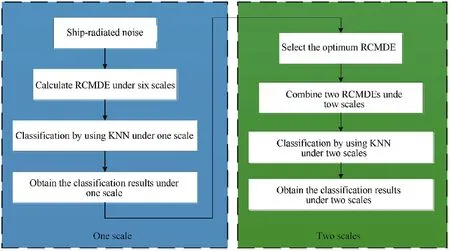
Fig.1.The flow chart of RCMDE-KNN for ship-radiated noise.

All the above shows the differences between MDE and RCMDE.





whereis the number of class, round() is the integer function.





(e) Forcoarse-grained results of RCMDE,the probability of one dispersion pattern can be represented as follows:

(f) Based on Shannon entropy definition,RCMDE can be defined as:

On the basis of the suggestions of parameter setting in Ref.[32],the recommended parameters of RCMDE are shown in Table 1.

Table 1The recommended parameters of RCMDE.
3.Results
In Section 3, numerical simulations are carried out on feature extraction and classification of ship-radiated noise based on MPEKNN, MW-PE-KNN, MDE-KNN, and RCMDE-KNN.In Section 3.1, a comparative study of four nonlinear dynamic methods for feature extraction of ship-radiated noise is carried out, including MPE,MW-PE, MDE, and RCMDE; in Section 3.2, a comparative study of four classification methods for ship-radiated noise is carried out under one and two scales,including MPE-KNN,MW-PE-KNN,MDEKNN, and RCMDE-KNN.
3.1.Feature extraction by using MPE, MW-PE, MDE, and RCMDE
We extract MPE,MW-PE,MDE,and RCMDE of four types of shipradiated noise.These ship-radiated noise are referred to as Ship A,Ship B,Ship C and Ship D,which are available online(https://www.nps.gov/glba/learn/nature/soundclips.htm).Fig.2 is the time domain waveforms for four types of ship-radiated noise.It can be seen from Fig.2 that the number of sampling points for each type of ship-radiated noise is 5×10,and each type of ship-radiated noise is normalized.In the previous study of ship-radiated noise, 5000 sampling points are usually used as a sample.Therefore,each shipradiated noise can be divided into 100 samples.By calculating the different multi-scale entropies of each sample, we can obtain the distributions of MPE, MW-PE, MDE, and RCMDE for four types of ship-radiated noise.Table 2 is the parameters of four multi-scale entropies, which is the same as those in Ref.[32].Figs.3-6 are the distributions of four multi-scale entropies for four types of shipradiated noise.

Table 2The parameters of four multi-scale entropies.
As can be seen from Fig.3, there are six scales from 1 to 6 for MPE; there is a significant difference in MPE between scale 1 and scale 2, and the MPE of each ship-radiated noise increases and decreases in varying degrees; unlike scale 1 and scale 2, the MPE distributions of four types of ship-radiated noise under the other four scales are very similar; for Ship C, it is easy to distinguish it under scale 1, but it is difficult under the other scales.As can be seen from Fig.4,the distributions of MW-PE for four types of shipradiated noise under six scales are similar to the distributions of MPE; unlike MPE distributions, due to the introduction of amplitude information into MW-PE,the values of MW-PE for four types of ship-radiated noise are significantly different from those of MPE.As can be seen from Fig.5,there is a small but crucial difference in the distributions of MDE for four types of ship-radiated noise under six scales; from scale 1 to scale 2, the values of MDE increased significantly for each ship-radiated noise; it is difficult to distinguish Ship B from Ship C under scale 1 and scale 2, however, this demerit is significantly improved under scale 4, 5, and 6; unlike MPE and MW-PE,Ship A is easily identified by using MDE.As can be seen from Fig.6,the distributions of RCMDE for four types of shipradiated noise under six scales are similar to the distributions of RCMDE; without coarse graining operation, MDE and RCMDE are the same under scale 1, which is consistent with the theories of MDE and RCMDE.The above experimental results show that four multi-scale entropies can represent the complexity differences of four types of ship-radiated noise under different scales.
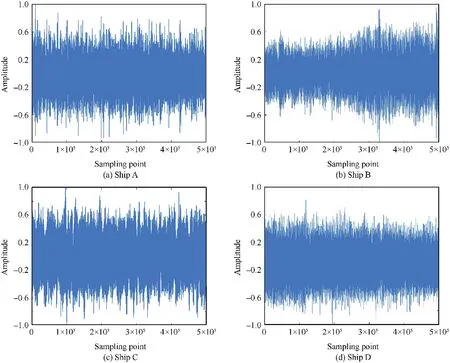
Fig.2.The time domain waveforms for four types of ship-radiated noise.

Fig.3.The distributions of MPE for four types of ship-radiated noise under six scales.
In order to better compare four multi-scale entropies,we carried out their statistical characteristics analysis by using mean and standard deviation(SD).Tables 3 and 4 are the mean and SD of four multi-scale entropies for four types of ship-radiated noise.As shown in Tables 3 and 4,their means of four multi-scale entropies are different under each scale,however,there are at least two close means under one scale, such as the means of MPE for ship C and ship D under scale 6 and the means of MDE for ship B and ship D under scale 2;without coarse graining operation,the mean and SD of MDE and RCMDE are the same under scale 1;with the amplitude weighted processing, the SD of MW-PE is different from that of MPE,on the contrary,the SD of MDE is close to that of RCMDE.The above analysis shows that,on the one hand,MDE and RCMDE have similar statistical characteristics;on the other hand,as the mean of MDE, RCMDE has better stability and is better as the complexity feature of ship-radiated noise.
3.2.Classification by using MPE-KNN, MW-PE-KNN, MDE-KNN,and RCMDE-KNN
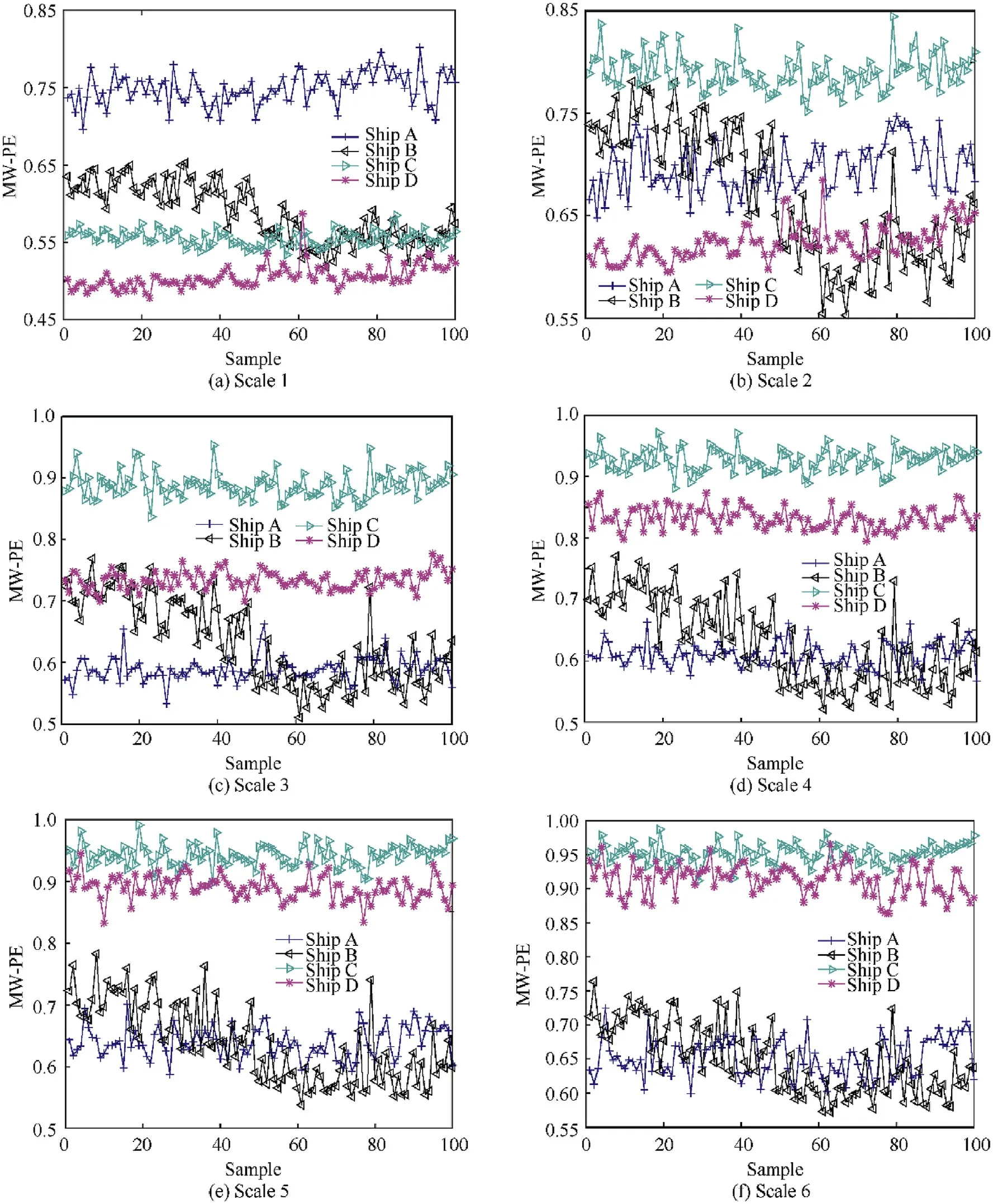
Fig.4.The distributions of MW-PE for four types of ship-radiated noise under six scales.
A comparative experiment is carried out for four types of shipradiated noise by using MPE-KNN, MW-PE-KNN, MDE-KNN, and RCMDE-KNN.For 100 samples of each ship-radiated noise, 20 samples are used as training set of KNN, and the remaining 80 samples are used as test set of KNN.Fig.7 is the recognition rates of four classification method for ship-radiated noise under six scales.As shown in Fig.7,for the same scale,the recognition rate of MPEKNN is close to that of MW-PE-KNN,and the same is true of MDEKNN and RCMDE-KNN; the recognition rates of four classification method are quite different under six scales, and the recognition rates of MDE-KNN and RCMDE-KNN are obviously higher than those of MPE-KNN and MW-PE-KNN; for MPE-KNN and MW-PEKNN, the highest recognition rates can be found under scale 1,while for MDE-KNN and RCMDE-KNN,the highest recognition rates can be found under scale 4.Table 5 shows the highest recognition rates of four classification methods under one scale.As shown in Table 5, MPE-KNN and MW-PE-KNN have the same highest recognition rate of 82.19% under scale 1; RCMDE-KNN has a recognition rate of 96.25% under scale 4, which is the best classification performance than the other three classification methods.However, the proposed classification method of RCMDE-KNN cannot completely distinguish four types of ship-radiated noise under one scale.
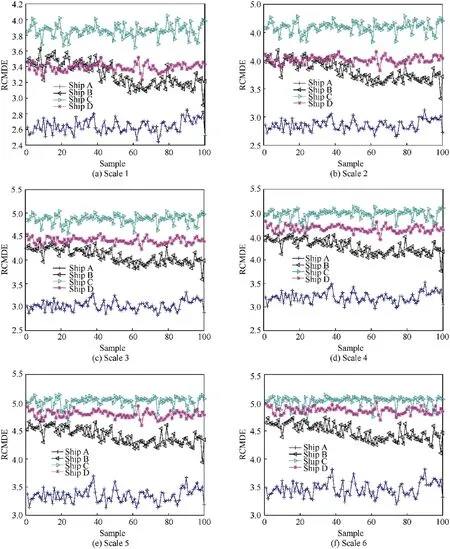
Fig.5.The distributions of MDE for four types of ship-radiated noise under six scales.
In order to improve the classification performance of RCMDEKNN under one scale, a comparative experiment is carried out for four types of ship-radiated noise under two scales by using MDEKNN and RCMDE-KNN.Because MDE-KNN and RCMDE-KNN have the highest recognition rates under scale 4,as the optimum RCMDE,we choose scale 4 as one of the two scales, and there are five combination forms by combining scale 4 and the other five scales,such as scale 4 and scale 1.Table 6 shows the recognition rates of MDE-KNN and RCMDE-KNN under two scales.As shown in Table 6,for both MDE-KNN and RCMDE-KNN under two scales, the lowest recognition rate is 99.06%, which is obviously higher than the highest recognition rates of MDE-KNN and RCMDE-KNN under one scale; MDE-KNN and RCMDE-KNN have the same recognition rate when scale 4 combines scale 1 and scale 3 respectively; for the other three combination forms, RCMDE-KNN has higher recognition rate than MDE-KNN; when scale 4 is combined with scale 2,the recognition rate of RCMDE-KNN reaches 100%.The experimental results show that the recognition rates of MDE-KNN and RCMDE-KNN can be further improved by using two scales; the recognition rate of the proposed RCMDE-KNN is better than that of MDE-KNN under two scales.
3.3.Classification by using KNN, RF, and DAC

Fig.6.The distributions of RCMDE for four types of ship-radiated noise under six scales.
In order to prove the effectiveness of KNN, a comparative experiment is carried out for four types of ship-radiated noise under one scale based on RCMDE by using KNN,random forest(RF),and discriminant analysis classifier (DAC).Same as the previous experiment, for 100 samples of each ship-radiated noise, 20 samples are used as training set,and the remaining 80 samples are used as test set.Fig.8 is the recognition rates of RCMDE for ship-radiated noise under six scales by using KNN,RF and DAC.As shown in Fig.8,the recognition rate difference of different classification algorithms under the same scale is very small; the recognition rates of the three classification algorithms all reach the maximum when the scale is 4.Table 7 shows the highest recognition rate of three classification algorithms under one scale.As shown in Table 7, the three classification algorithms all reach the maximum when the scale is 4,and the difference in recognition rate is within 2%;among them, the recognition rate of KNN is the highest, reaching 96.25%;and DAC has the lowest recognition rate of 94.55%.Experimental results show that the three classification algorithms have similar recognition rate,and KNN has better performance than RF and DAC under scale 4.
In order to further verify the classification performance of KNN,a comparative experiment is carried out for four types of shipradiated noise under two scales based on RCMDE by using KNN,RF, and DAC.In view of the three classification methods all achieving the highest recognition rate when the scale is 4, wechoose scale 4 as one of the two scales, and there are five combination forms by combining scale 4 and the other five scales,such as scale 4 and scale 1.Table 8 shows the recognition rates of three classification algorithms under two scales.Like Table 7, the recognition rates of the three classification algorithms under two scales are also very close.KNN has a recognition rate of 100% when the scale is 4 and 2, which is the best classification performance than the other two classification algorithms.On the one hand, the experimental results further verified the recognition rates can be further improved by using two scales; on the other hand, it also proved that the classification algorithm is not the dominant core of classification in this paper, and KNN has the highest recognition rate under one and two scales.
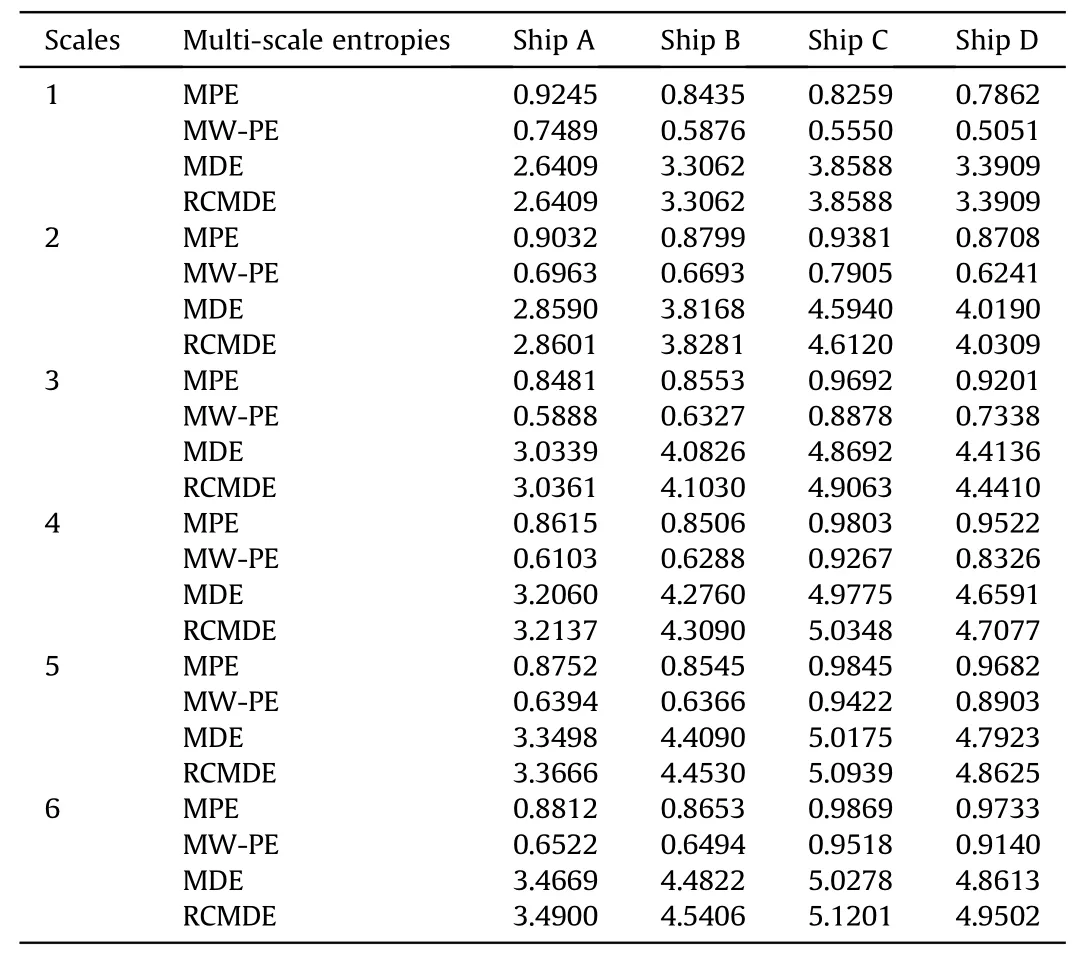
Table 3The mean of four multi-scale entropies for four types of ship-radiated noise.
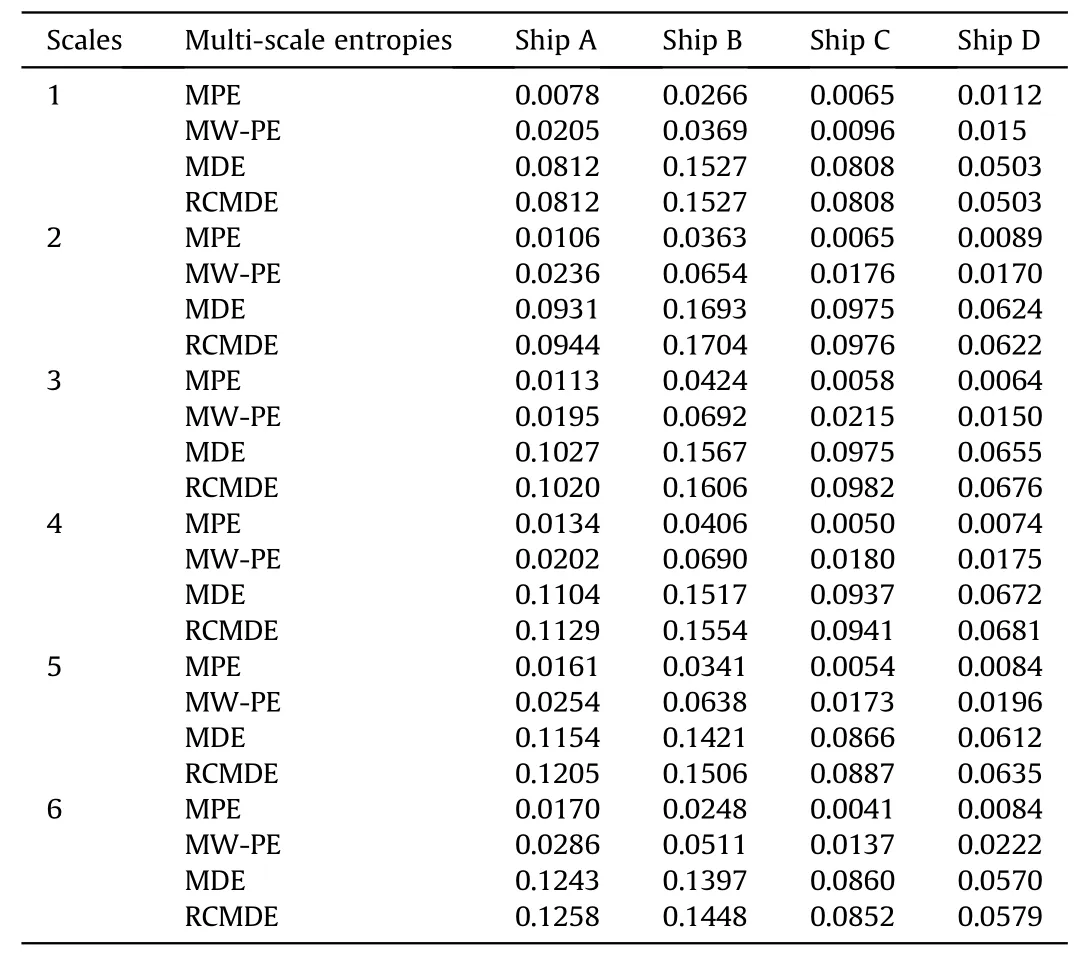
Table 4The SD of four multi-scale entropies for four types of ship-radiated noise.

Table 5The highest recognition rates of four classification methods under one scale.

Table 6The recognition rates of MDE-KNN and RCMDE-KNN under two scales.

Table 7The highest recognition rate of three classification algorithms under one scale.

Table 8The recognition rates of three classification algorithms under two scales.
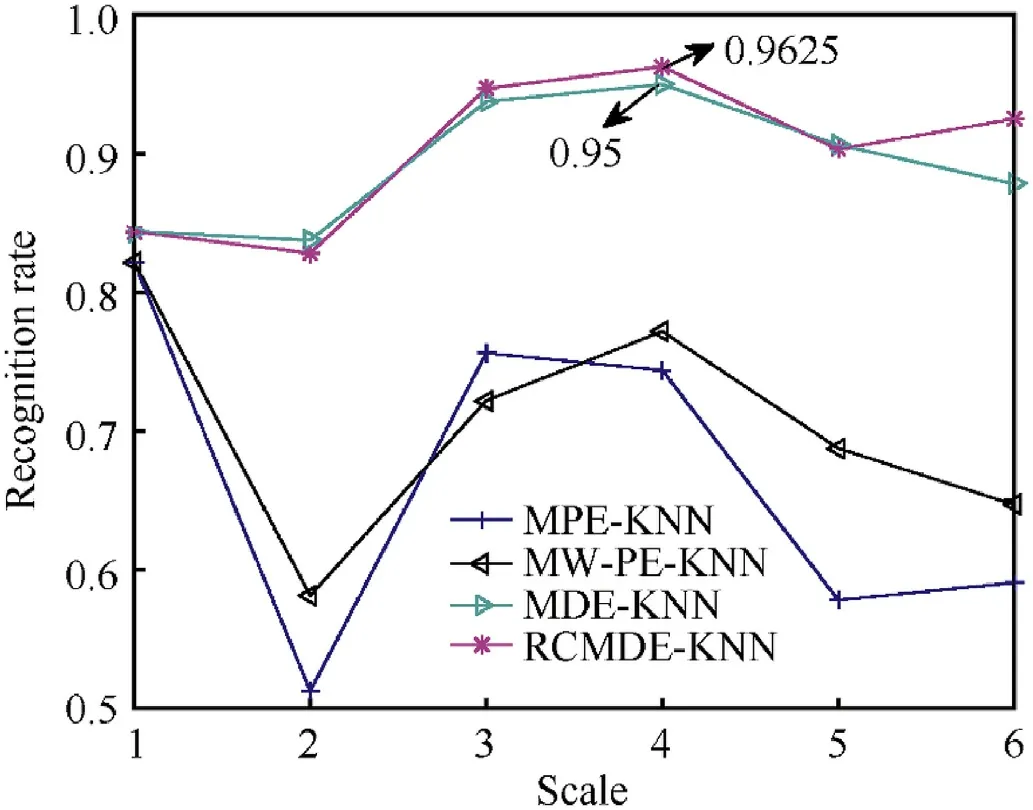
Fig.7.The recognition rates of four classification method for ship-radiated noise under six scales.
4.Conclusions
RCMDE, as a new nonlinear dynamic method, is applied to the feature extraction of ship-radiated noise, and then a classification method called RCMDE-KNN is proposed based on RCMDE and KNN.A comparative experiment is carried out for four types of shipradiated noise by using MPE-KNN, MW-PE-KNN, MDE-KNN, and RCMDE-KNN.Through a large number of simulation analysis, we can draw the following conclusions:
(1) Like MPE, MW-PE, and MDE, RCMDE can be used as an effective complexity feature of ship-radiated noise.As an improved method of MDE,RCMDE has better stability and is more suitable for feature extraction of ship-radiated noise.
(2) Compared with the classification methods of MPE-KNN,MW-PE-KNN, and MDE-KNN, the proposed classification method of RCMDE-KNN has better classification performance under one scale, and its highest recognition rate is 96.25%.
(3) Compared with MDE-KNN and RCMDE-KNN under one scale,their classification performance can be further improved under two scales.Moreover, the highest recognition rate of RCMDE-KNN can reach 100% under two scales, which is higher than that of MDE-KNN under the same conditions.
(4) Compared with KNN, RF, and DAC, KNN has the highest recognition rate under one and two scales for RCMDE of shipradiated noise.

Fig.8.The recognition rates of RCMDE for ship-radiated noise under six scales by using KNN, RF, and DAC.
Authors gratefully acknowledge the supported by National Natural Science Foundation of China(No.61871318 and 61833013)and Shaanxi Provincial Key Research and Development Project(No.2019GY-099).
The authors declared that they have no conflicts of interest to this work.
杂志排行
Defence Technology的其它文章
- A fast and accurate model for the creation of explosion fragments with improved fragment shape and dimensions
- External blast load factors for dome structures based on reliability
- Ignition of nanothermites by a laser diode pulse
- Improving the energy release characteristics of PTFE/Al by doping magnesium hydride
- Buckling analysis of shear deformable composite conical shells reinforced by CNTs subjected to combined loading on the two-parameter elastic foundation
- Machine learning and numerical investigation on drag reduction of underwater serial multi-projectiles
